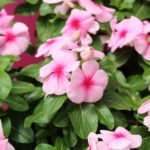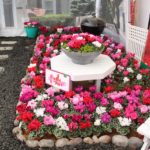Duets: Plant pathology perspective from floriculture royalty
Joining me today is Margery Daughtrey, Ph.D., senior Extension associate at Cornell University’s Long Island Horticultural Research & Extension Center in Riverhead, New York. Margery earned her bachelor’s degree at The College of William and Mary in biology, her master’s at the University of Massachusetts in plant pathology, and a doctorate at Cornell University in plant pathology.

She started her career as an extension associate on Long Island in 1978 focusing on diseases of ornamental plants. Daughtrey continues to work with greenhouses, nurseries and tree companies, running a diagnostic lab, conducting research and participating in Extension activities that include problem solving, writing and speaking on plant disease management.
Peter: Welcome to Duets, Margery, a fun question to start: How did you become interested in plants and horticulture as a career path?
Margery: I was hooked on science as a career during a field trip in kindergarten, when we saw a fly in mind-blowing detail through a microscope in a friend’s father’s laboratory. My best friend and I had marvelously encouraging teachers at school and spent many happy hours in the woods and by the creek, seeking out wildflowers, Golden Nature Guide in hand. At home, my parents grew azaleas, nasturtiums, apple trees, corn and lettuce, and I had potted begonias on my windowsill.
Peter: Well sister, you win! No one in this column’s eight years has cited kindergarten as career defining. You brought back memories as we’re of the same generation that grew up exploring nature and science in the woods. My neighborhood group spent hours in the woods and fields with joyful imaginations. Our parents didn’t know where we were but trusted us to stay out of trouble. My wife and I feel badly that our children missed that fun — youngsters today are in so many organized activities. What’s your view of the current state of plant pathology as it relates to commercial growers?
Margery: When I think back over the past, I see all the contributions that plant pathologists have made to help growers make good everyday decisions — and to bail them out of deep problems. When bacterial blight was the scourge of field-stock geraniums in the ‘50s, it was partnership between great minds in industry and universities that led to an effective culture-indexing system that made it safe to grow geraniums again.
When powdery mildew appeared on poinsettias, plant pathologists worked out the scouting and treatments to halt the total crop losses that would have occurred if the fungus had had its way, and they spread the news to growers. When the Western flower thrips extended its territory and began carting impatiens necrotic spot virus all over the place, university research defined the problem, worked on solutions and did a massive extension effort to help growers protect their crops.
When impatiens downy mildew rocked the bedding plant industry, USDA-ARS and university researchers working with the industry and provided critical information and extensive extension efforts to help businesses survive that threat.
Peter: Your perspective to those outbreaks is valuable, they were challenging for everyone involved. Revisiting them brings appreciation for the connections between research, extension and production and how effectively these connections have served floriculture.
I sense a difference in how the two of us operate, research-wise. Much of my work has been in plant growth regulation where products are used to improve crop quality rather than address crop survival. Your work deals with crop life and death. Identify a pathogen, find a remedy, educate growers. I consider your conference presentations to be appointment viewing knowing you are always timely, informative and genuinely committed to helping growers. Watching you operate led me to the descriptor “Floriculture Royalty” for this article but you eclipsed me by suggesting “Princess Mildew” is more appropriate. Details please.
Margery: Oh, Marc Cathey (floricultural researcher and director of the National Arboretum) used to call me that, and he and Andre Viette (New York and Virginia nurseryman, breeder of daylilies and garden talk radio host) once sent me a “Princess Mildew” costume from some Caribbean island. Later, powdered sugar appeared on just Jan Hall’s and my poinsettia plates at a Poinsettia Growers Association Conference … and, knowing my niche, I’ve stayed in the mildew category with my downy mildew work.
Peter: Moving on, progress and change in both the academic and production sectors of horticulture are constants. How is plant pathology changing?
Margery: Today I think much of the role played by ornamental pathologists at universities in the past has shifted over to pathologists working for the large breeding companies. In academia, working on ornamental crops is not seen to bring in enough funding to sustain a research program — enough that an assistant professor can get tenure.
Dollar expectations for funding of university programs are now in the millions. Consequently, as ornamental pathologists retire, they are not being replaced with people who can troubleshoot problems for the industry — they are more likely to have microbial genetics expertise with crossover relevance to human diseases or diseases of major food crops.
These scientists will make huge and essential contributions to knowledge, but will the flower industry find them to be relevant to their businesses? With fewer professors of floriculture pathology, the industry will lose teachers and resilience for dealing with current disease problems. Private industry will fill the gap, but possibly with reduced objectivity and sharing.
Peter: These are important issues. Growers need to be aware of your concerns because they are the ones who influence those who decide which sector(s) get support. We can sound alarms but it’s the voice of the growers that carries the most weight. Your point about private sector objectivity is excellent as well. I’ve experienced it after choosing to leave academia to operate in the private sector. It takes extra effort to establish and steward a reputation of objectivity here.
Regarding diagnosing crop problems, long ago my graduate advisors taught growers to “test — don’t guess” about plant nutrition. Guessing incorrectly escalated symptom expression, delayed corrective response and jeopardized crop salability.
Today, we have handheld meters that are indispensable in a grower’s nutrition monitoring. What’s your position regarding remote diagnostic technology and what growers can do on site versus using a plant pathology lab?
Margery: Do growers need to test when they see potential disease symptoms, and do growers have technology now that helps them to do it themselves? Of course I agree with your advisors, that knowing is far better than guessing. It’s pointless to spray fungicides on bacteria or viruses. Plus growers often think they have made a cultural error when there is actually a pathogen that is messing up their crop, and vice versa.
I immediately think of impatiens necrotic spot and tomato spotted wilt when I think about new technology and diseases. These two viruses were a bewilderment when they first came on the scene: different symptoms on different crops, different symptoms on different ages of the same crop, different symptoms on different cultivars.
A lot of visual education was needed from extension pathologists.
But then Agdia began developing do-it-yourself test kits that growers could afford and easily use, and the final diagnosis no longer had to be guesswork or formally executed in a laboratory. Other companies have followed suit with similar products, and today we can test for some bacteria, some fungi, Phytophthora and many viruses with what are called lateral-flow devices.
Technology took on a key IPM support role and allowed on-site diagnosis of a widespread, hard-to-identify and significant disease problem. This solved the need for information but didn’t solve the need for advice. And laboratory testing is still essential for some businesses and for the detection of unanticipated problems.
Peter: What do you think of apps for disease ID?
Margery: I confess that I laughed when an entrepreneur proposed to me that he would gather enough photographs to create a tool that growers could use to diagnose diseases. I thought such methods could never replace a good diagnostician. But now I use Cornell Lab of Ornithology’s Merlin Bird ID program to listen to birds and tell me which one is singing. It’s magical! Given properly screened inputs, this kind of approach will eventually surpass most people’s ability to sight-identify a disease. Today, we can even get DNA sequences of pathogens to find out what they really are.
This kind of thing won’t replace the need for those who are talented at problem analysis, who understand plant production systems, the crops and the possible pathogens. But there is certainly an information revolution going on. I would hate to go back to the time before digital photography, emails and ImmunoStrips! I staunchly believe in truthing conclusions with laboratory cultures and pathogenicity trials, though. New crop enemies, which emerge every year, can never get identified if we assume that the problem before us has been known about for years.
Peter: Thank you “Princess Mildew” (a.k.a Floriculture Royalty) for sharing your awesome insights.









 Video Library
Video Library 


















